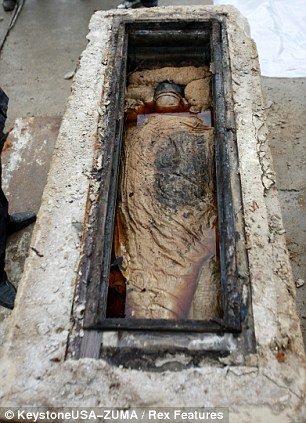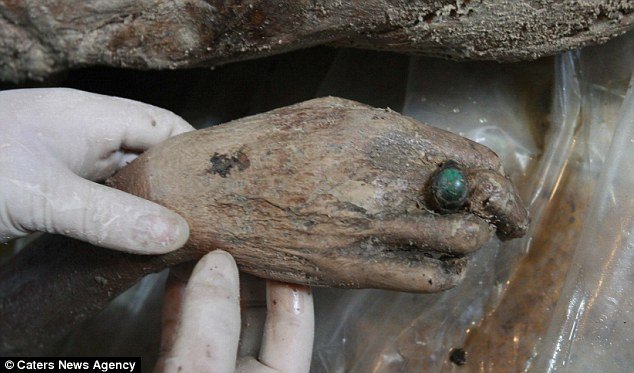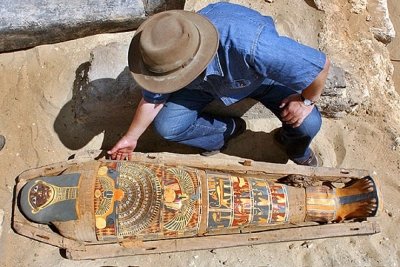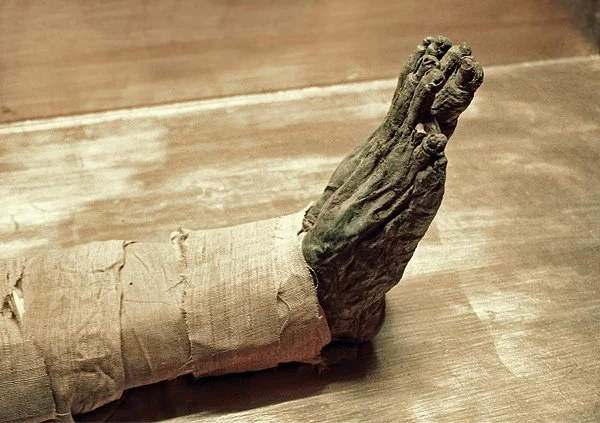Not too long ago, our early human ancestors were under constant threat of attack from predators. And it turns out that this difficult chapter in our history may be responsible for the adaptations that allowed us to become so successful.
Archaeologists investigate the famous pharaoh's tomb and the mysteries of his missing stepmother
If the investigations into King Tut's tomb reveal hidden rooms, could those chambers hold the burial of Nefertiti, the long-lost queen who is doubly connected to the teenage pharaoh? If so, they might add one more mummy to his intriguingly interwoven family ties.
More than a century of excavations in and around Egypt’s Valley of the Kings has revealed 64 tombs and other related chambers. The treasure-filled burial of King Tutankhamun, known now as KV62, is by far the most famous. But many other royal tombs and mummies from ancient Egypt's 18th and 19th Dynasties have also come to light.
Beginning in 2007, Egyptian scientists conducted genetic tests on 16 royal mummies. Those pictured here were identified as Tut's near and dear—his grandparents, his parents, his wife, and two mummified foetuses who were found in his tomb and were most likely his daughters.
But there's one legendary royal mummy from this period who’s missing, and whose name pops up every time there's a new discovery in this royal cemetery—the beautiful Queen Nefertiti. She was the principal wife of Akhenaten, Tut's father. Tut's mother was a different wife, whose name we don't know. That makes Nefertiti Tut's stepmother.
Tut's family ties are further complicated by the royal custom of incest during this period. Tut married his half sister Ankhesenamun, a daughter of Nefertiti and Akhenaten. And that makes Nefertiti his mother-in-law.
Africa: Zulu Empire - Shaka Zulu Becomes King
With no written records from the Zulus themselves, historians and anthropologists have pieced together their history from a smattering of sources. We first learn of the Zulu as a minor tribe of the Bantu people, living in South Africa. Shaka Zulu, the man who would organize them into an empire, was born the illegitimate son of a Zulu king. He was sent away with his mother Nandi to grow up in her tribe, the Langeni, but he eventually caught the attention of Dingiswayo, the leader of another powerful tribe called the Mtethwa. Appointed as the leader of a squadron called an ibutho, Shaka developed new tactics including a short "iklwa" fighting spear and a simple but effective military maneuever called "the Bull Horn." When his father died, Shaka - now a successful military leader - returned with Dingiswayo's backing to assassinate the rightful heir and assume control of his native tribe. Just a year later, though, the neighboring Ndwandwe tribe murdered Dingiswayo and Shaka vowed revenge on their leader, Zwide. He then launched a bloody war that, combined with the strains created by European colonization, led to the Mefacane, or the Crushing.
Witch Hunt: The Brutal And Bizarre World Of Jacobean Britain
Four hundred years ago, hundreds of innocent people were killed as an obsession to stamp out Satanism swept the British Isles. A brutal scourge plagued Britain in the 17th century, taking many innocent lives along with it. Dr Suzannah Lipscomb investigates the origins of the obsession for mass witch-hunts.
Buddhism Explained Simply
Buddhism is one of the world’s major religions. But outside of Asia it isn’t very well known. What is Buddhism? Who was the Buddha? What do Buddhists Believe? Thats what we’ll find out in this video.
We will learn about the life of the Buddha. The 4 Noble truths that he taught will be explained. The way to Nirvana, the Noble Eightfold Path will also be explained.
What Being a Spectator at the Rome Colosseum Was Like
Ancient Romans loved their sports and entertainment, and the Colosseum put on the grandest games in all of ancient Rome. With its gladiators, interchangeable arenas, exotic animals, and the rare naval reenactment, being a spectator in the Roman Colosseum would have indeed been a spectacle.
Crowds of 50,000 people, spanning every region and socioeconomic class of the empire, gathered at the stadium to watch shows and get away from the disgusting life of everyday Rome. They enjoyed food, wine, music, and theatrics in a large venue, all paid for by the emperor himself.
Nefertiti's Daughters & The Sisters Of Tutankhamun (Full Documentary)
In the video below we will discover the lives of all 6 children that Queen Nefertiti was mother to, and the fate of the sisters of Tutankamun. Enjoy!
What Caused the Roman Empire to Collapse
What happens when an Empire fails to enforce its rule? Empires FALL! Check out today's epic new video about the great Roman Empire and how a few wrong moves led to the Empire's total collapse!
A 700-Year-Old Mummy Perfectly Preserved In Brown Liquid Appears To Be Only A Few Months Old
These incredible pictures show a 700-year-old mummy, which was discovered by chance - by road workers - in excellent condition in eastern China.
The corpse of the high-ranking woman believed to be from the Ming Dynasty - the ruling power in China between 1368 and 1644 - was stumbled across by a team who were looking to expand a street.
And the mummy, which was found in the city of Taizhou, in the Jiangsu Province, along with two other wooden tombs, offers a fascinating insight into life as it was back then.
Discovered two metres below the road surface, the woman's features - from her head to her shoes - have retained their original condition, and have hardly deteriorated.
When the discovery was made by the road workers, late last month, Chinese archaeologists, from the nearby Museum of Taizhou, were called into excavate the area, the state agency Xinhua News reported.
They were surprised by the remarkably good condition of the woman's skin, hair, eyelashes and face. It was as though she had only recently died.
Her body, which measures 1.5 metres high, was found at the construction site immersed in a brown liquid inside the coffin.
And the coffin was opened earlier this week, on March 1, much to the excitement of the local city - and further afield. And the right hand of the 700-year-old mummy showed her preserved skin, and a ring.
The mummy was wearing traditional Ming dynasty costume, and also in the coffin were bones, ceramics, ancient writings and other relics.
This is the latest discovery after a lull of three years in the area. Indeed, between 1979 and 2008 five mummies were found, all in very good condition.
Those findings raised the interest in learning the techniques to better understand the Ming dynasty's expertise in mummifying as well as their funeral rituals and customs.
Director of the Museum of Taizhou, Wang Weiyin, told Xinhua that the mummy's clothes are made mostly of silk, with a little cotton.
He said usually silk and cotton are very hard to preserve and excavations found that this mummifying technology was used only at very high-profile funerals.
The first finding of the Ming Dynasty in Taizhou dates from May 1979 and led the opening of the museum.
At that time the bodies were also found intact, but due to lack of experience of archaeologists only clothing, belts and clamps could be preserved.
The Ming Dynasty, who built the Forbidden City and restored the Great Wall, was the last in China and marked an era of economic growth and cultural splendour which produced the first commercial contacts with the West.
Bizarre & Mysterious Discoveries
In the following video we will be exploring some bizarre and mysterious discoveries. Watch the video for more and enjoy!
10 Most Mysterious Historical Coincidences!
In the following video we will be analyzing 10 of the most mysterious historical coincidences. Enjoy!
A 2,300-year-old mummy unveiled in Egypt
A superbly maintained 2,300-year-old mummy bearing a golden mask and covered in brightly colored images of gods and goddesses was unveiled Tuesday at Egypt's Saqqara Pyramids complex south of Cairo.
The unidentified mummy, from the 30th pharaonic dynasty, had been closed in a wooden sarcophagus and buried in sand at the bottom of a 20-foot shaft before being discovered recently by an Egyptian-led archaeological team.
"We have revealed what may be the most beautiful mummy ever found in Egypt," Zahi Hawass, chief of Egypt's Supreme Council of Antiquities, said as he helped excavators remove the sarcophagus' lid to show off the find.
Hawass said experts will use CT scanning technology within the next week to reveal more details about the ancient Egyptian's identity and he had lived and died.
Afterward, the mummy will be displayed at Saqqara's museum of Imhotep, the famed architect who designed the Stepped Pyramid — Egypt's oldest.
The mummy, found two months ago, was covered from head to toe in brightly colored cartonage burial material depicting a range of graphic scenes, including the Goddess Maat of balance and truth who was shown with outstretched arms that took the shape of feathered wings.
Also shown were the four children of the falcon-headed god, Horus, and the rituals and processes to mummify the person, who Hawass believed must have been wealthy considering his burial location and fine gold used for the mummy's mask.
"The artists who made this mummy more than 2,000 years ago demonstrated the brilliance of the ancient Egyptians by using stunning colors and depicting his face so graphically," Hawass said.
The mummy had been buried within the necropolis of King Teti, a funerary area containing scores of burial chambers, false doors that ancient Egyptians said the souls of the dead would use to leave their tombs, and temples.
The necropolis is built alongside the collapsed pyramid of Teti, who ruled during ancient Egypt's 6th dynasty, more than 4,300 years ago. Hawass said a "lost" pyramid had been located in the Saqqara area and would be uncovered after two months.
Saqqara, located about 12 miles south of Cairo, is one of Egypt's most popular tourist sites and hosts a collection of temples, tombs and funerary complexes.
24,000-Year-Old Animal Found Alive After Being Preserved in Siberian Permafrost
During the Upper Paleolithic era, a multicellular organism was frozen almost the time in history when humans first set foot into North America. About 24,000 years later, it has been found alive after sleeping for millennia.
This turned out to be a very huge discovery and might have changed the theory of how long organisms and perhaps humans can be preserved for generations.
Discovery of Bdelloid Rotifer
Bdelloid rotifer – a freshwater creature – is too tiny to see with the naked eye, measuring around 150 and 700 μm. The microorganism can be found in waters around the world. This animal survived being frozen for many years through a remarkable means of cloning itself multiple times through an asexual reproduction form called parthenogenesis, according to Accuweather.
This discovery, therefore, brought about questions on the reversible standstill lack of life theory or mechanism of the cryptobiosis.
These findings were done by researchers from the Soil Cryology Laboratory in Pushchino, Russia. It was discovered from a soil sample collected from permafrost in northeastern Siberian.
This age discovery was really surprising to the researcher as it felt really unbelievable that the animal was alive and doing well.
The permafrost sample of this creature was collected from the Alazeya River, which flows from Siberia into the Arctic. Researchers also confirmed that there was no movement of the bdelloid rotifer due to the icy nature of the ground.
Research Findings
“The takeaway is that a multicellular organism can be frozen and stored as such for thousands of years and then return back to life – a dream of many fiction writers,” Malvin, an author on this study stated.
He further talked about how big this discovery was and how it has totally changed the ideology of organism preservation.
This discovery might have been revolutionary and has added to the small number of organisms that have been found to be able to survive such extraordinary timespans but more are still yet to be uncovered.
The more complex an organism becomes, the more difficult it is to preserve alive, like in mammals, as per Smithsonian Magazine.
Other Organisms That Survived Extraordinary Timespans
In Russia, a pair of prehistoric nematodes, also called roundworms, were discovered and successfully revived, it is said to have been between 30,000 and 42,000 years old.
Studies have shown that over the years, a lot of organisms have been revived from their frozen state but what makes this new discovery more interesting is that none of these past organisms is as complex as the bdelloid rotifer.
Additionally, there have been discoveries on the dead but frozen larger species like the 20,000-year-old woolly rhino that was discovered by a Siberian farmer in the area of Yakutia in 2021 and the 57,000-year-old Pleistocene grey wolf puppy, the most perfectly preserved animal of its kind.
More research is still to be made on this study. The hope is that insights from these tiny animals will offer clues as to how better to cryo-preserve the cells, tissues, and organs of other animals, including humans.
A student found an ancient Canadian village that’s 10,000 years older than the Pyramids
An ancients village dating back to before the Pyramids era was discovered by a team from Canadian Ph.D. students.
CTV reports that a team of students from the University of Victoria’s archeology department has uncovered the oldest settlement in North America.
This ancient village was discovered when researchers were searching Triquet Island, an island located about 300 miles north of Victoria, British Columbia.
The team found ancient fish hooks and spears, as well as tools for making fires.
However, they really hit the jackpot when they found an ancient cooking hearth, from which they were able to obtain flakes of charcoal burnt by prehistoric Canadians.
Using carbon dating on the charcoal flakes, the researchers were able to determine that the settlement dates back 14,000 years ago, making it significantly older than the pyramids of Ancient Egypt, which were built about 4,700 years ago.
To understand how old that truly is, one has to consider that the ancient ruler of Egypt, Cleopatra lived closer in time to you than she did to the creation of the pyramids.
Even to what we consider ancient people, the Egyptian pyramids were quite old.
This newly discovered settlement dates back more than three times older than the pyramids.
Alisha Gauvreau, a Ph.D. student who helped discover this site said, “I remember when we got the dates back, and we just sat back and said, ‘Holy moly, this is old.’”
She and her team began investigating the area for ancient settlements after hearing the oral history of the indigenous Heiltsuk people, which told of a sliver of land that never froze during the last ice age.
William Housty, a member of the Heiltsuk First Nation, said, “To think about how these stories survived only to be supported by this archeological evidence is just amazing.”
“This find is very important because it reaffirms a lot of the history that our people have been talking about for thousands of years.”
Researchers believe that this settlement indicates a mass human migration down the coast of British Columbia.
“What this is doing, is changing our idea of the way in which North America was first peopled, said Gauvreau.”
The students hope to continue to search nearby islands for more evidence of this migration.
Mythical Creatures That Actually Existed!
Check out these mythical creatures that actually existed! Who knew that animals like griffins, cyclopes, unicorns, dragons, rocs and big foot could actually be real!
Investigating the Iron Plate found in the Great Pyramid - is it legit?
In 1837, a man on Howard Vyse’s expedition at the Great Pyramid of Giza - named J. R. Hill - found a thin iron plate lodged between stones near the opening of the King’s Chamber’s Southern Shaft. This discovery, if contemporary to the building of the pyramids, calls into question what we know about the historical timeline of metalworking. But is there any legitimate evidence for this? And why is this iron plate often omitted from conversations about the Great Pyramid?
Greek Philosophy: Socrates' Life and Methods
Who was Socrates of Athens? Today’s video is an introduction to his life and methods. Enjoy!
Greek Philosophy: Socrates' Philosophy
In this video we will be talking about Socrates' philosophical ideas. Enjoy!
Pompeii The Discovery with Dan Snow - Unveiling the Secrets of the Ancient City
Welcome to historian and presenter Dan Snow's enthralling tour of the historic city of Pompeii! Dan Snow leads us on an unforgettable journey in this episode of "Pompeii The Discovery" as we uncover the long-forgotten secrets of this famous city, providing a unique look into the lives of its citizens and the tragic incidents that altered its course.
Dan Snow delves deeply into the rich history and cultural significance of Pompeii thanks to his exclusive access to the most recent archaeological finds and cutting-edge technology. As we stroll through the beautifully preserved streets, marvel at the lavish homes, temples, and public baths, and discover the daily routines of the people who once flourished in this bustling city, we will be following in the footsteps of the ancient Romans.
But the story doesn't end there. Through captivating interviews with leading experts and historians, Dan Snow reveals the heart-wrenching tale of the catastrophic eruption of Mount Vesuvius that buried Pompeii under a thick layer of volcanic ash, preserving it in time for centuries. Discover the harrowing details of the disaster and its aftermath, and learn how it forever altered the course of history.
Ethiopia’s Chapel in the Sky
If churches were assessed by their risk factor, Abuna Yemata Guh would be our new Sistine Chapel. Perched 650 feet above a steep cliff in Northern Ethiopia, visitors face a 45-minute climb up the cliff’s vertical face in order to access the precariously positioned church. Dating back to the 5th century, history has it that its founder Father Yemata built the chapel to be closer to heavenly spirits; however, others claim it was a strategic move to avoid his enemies.






















